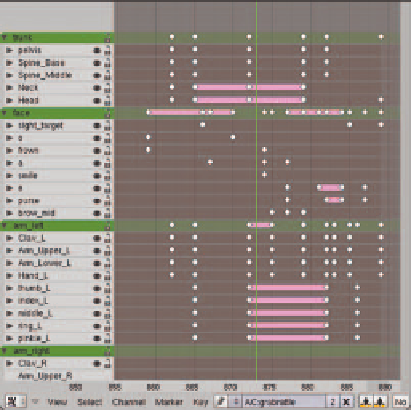Graphics Reference
In-Depth Information
This functionality is also available from the
Interpolation Mode
section of the
Key
menu on the Action
Editor header.
In
Constant
mode, poses do not blend from one to the next. Instead, they snap into existence on their exact
keyframe, holding the pose until the next key is encountered in the timeline. By setting poses in constant
mode, you get something between the “chess pieces” animatic you created before and a full blown animation.
Also, because you are only working with the key poses and not anticipation/overlap/etc., the Action Editor
stays relatively clean. This makes it much easier to adjust the timing of the main poses before the Action
Editor acquires the lovely (pronounced “messy”) look that the full animation process will give it. Figures
11.17 and 11.18 show the difference.
Figure 11.18
The Action Editor full of keyframes from a
refi ned animation
Figure 11.17
The Action Editor at the fi rst stage of pose
to pose animation
After getting things to look right in Constant interpolation mode, you “release” the animation into normal
Bezier interpolation and begin to add anticipation, overlap, follow through, and secondary motion and to
adjust the timing of the interpolations.
A Practical Example
For the vast majority of
The Beast
, I used a hybrid approach. I found the straight ahead method to be too
loose, while pose to pose was rather restrictive. What I had arrived at by the end of production, and what I
will demonstrate here, was a straight ahead approach to create the main poses, followed by a pose to pose style
review and refi nement.


Search WWH ::

Custom Search